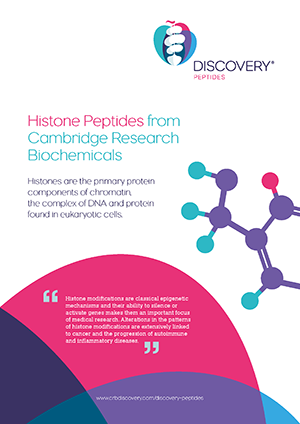Histone H3 (1-20) K4Me3, K9Ac, pS10-GG-Biotin 0.5mg
ART-K(Me3)-QTAR-K(Ac)-[pS]-TGGKAPRKQL-GG-[K(Biotin)]-amide
Description
Application Data
Description
-
Histone H3 (1 – 20) K4Me3 is derived from Histone 3 (H3) which is one of the four core histones fundamental for compacting eukaryotic DNA into the nucleosome. Lysine 4 of Histone H3 (1 – 20) K4Me3 has been tri-methylated, lysine 9 has been acetylated, serine 10 has been phosphorylated and labelled with Biotin
Application Data
-

Material Safety Data Sheet (MSDS)Catalogue number crb10016825 Molecular Weight 2814.5 Sequence (one letter code) ART-K(Me3)-QTAR-K(Ac)-[pS]-TGGKAPRKQL-GG-[K(Biotin)]-amide
Sequence (three letter code) H-Ala-Arg-Thr-[Lys(Me3)]-Gln-Thr-Ala-Arg-[Lys(Ac)]-[pSer]-Thr-Gly-Gly-Lys-Ala-Pro-Arg-Lys-Gln-Leu-Gly-Gly-[Lys(Biotin)]-NH2
Modifications Lysine 4 of Histone H3 (1 - 20) K4Me3 has been tri-methylated, lysine 9 has been acetylated, serine 10 has been phosphorylated and labelled with the Biotin. Purity >95% Storage -20°C References Hyland et al (2005) Insights into the Role of Histone H3 and Histone H4 Core Modifiable Residues in Saccharomyces cerevisiae. Mol. Cell. Bio. 22 10060 PMID: 16260619
Kothapalli et al (2006) Biological functions of biotinylated histones. J. Nutr. Biochem. (7) 446 PMID: 15992689
Henneman et al (2018) Structure and function of archaeal histones. PLoS Genet. 14(9) e1007582 DOI: https://doi.org/10.1371/journal.pgen.1007582
Manufactured in: United Kingdom Histone H3 (1 – 20) K4Me3 is derived from Histone 3 (H3) which is one of the four core histones (H2A, H2B, H3 and H4) fundamental in compacting eukaryotic DNA into the nucleosome. The nucleosome arises when 147 base pairs of DNA wrap around a H3-H4 tetramer and two H2A-H2B dimers, forming the histone octamer core. Both H4 and H3 are highly conserved and perform roles in binding to segments of DNA which enter and leave the nucleosome and in chromatin formation. Similar to the other core histone, H3 has a globular domain and a flexible N-terminal domain, “histone tail” which can undergo modifications such as acetylation, methylation, phosphorylation and ubiquitination. Due to histones containing a large number of lysine and arginine residues they have a positive net charge which interacts in an electrostatic manner with the negatively charged phosphate groups in DNA. The transcriptional activation or silencing of the chromatin is controlled by ATP-dependent chromatin remodelling factors and histone modifying enzymes which target histone proteins. Both processes function to alter the positioning of the nucleosome, allowing the DNA it to be either available or inaccessible to the transcription machinery.
Lysine 4 of Histone H3 (1 – 20) K4Me3 has been tri-methylated, lysine 9 has been acetylated, serine 10 has been phosphorylated and labelled with Biotin.


